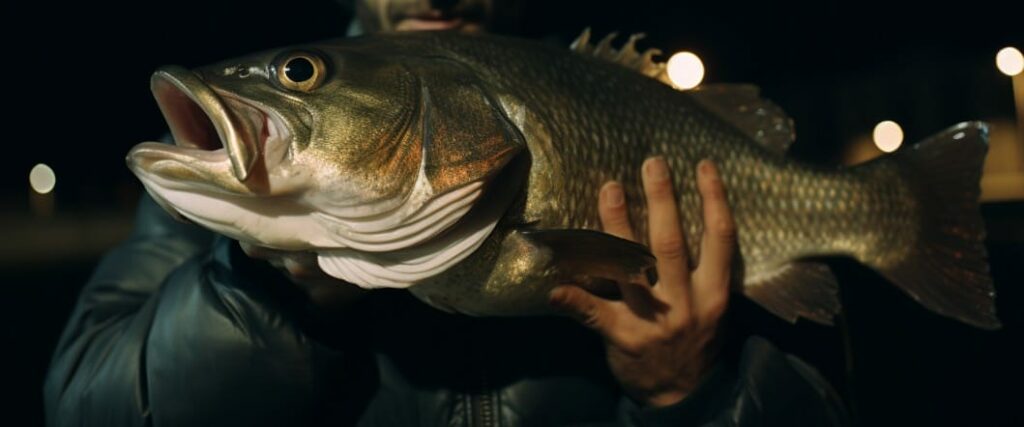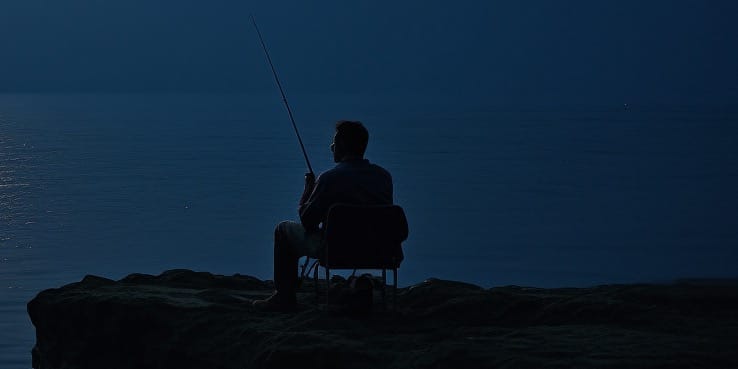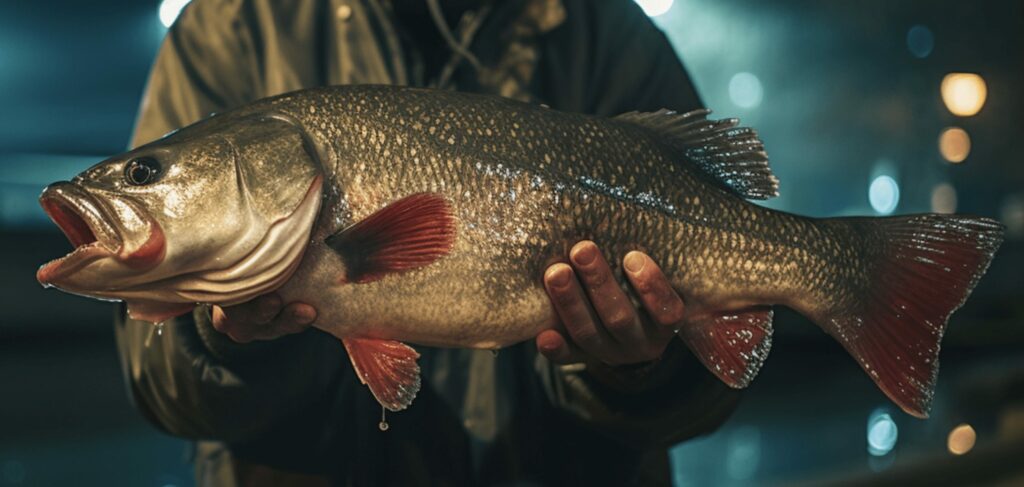When bass fishing at night, especially during the scorching summer months, the right strategies can elevate your fishing game.
So, how do you maximize your chances of landing that trophy bass when the sun goes down?
In this comprehensive guide, we’ll dive deep into the nocturnal world of bass fishing. We’ll explore the nuances of being stealthy, the impact of moon phases, advanced techniques, and the essential gear you’ll need for a successful night out on the water.
Let’s do it!
The Importance of Being Stealth

Let’s talk about the senses of bass at night.
These fish aren’t just floating aimlessly in the dark; they’re finely-tuned predators. Their senses are heightened, especially their sense of hearing and lateral lines that pick up vibrations.
So, the first rule of thumb is to be as stealthy as possible as any unnecessary noise or sudden movements can send these fish into the abyss.
So—how do you make these bass bite while being stealth?
You’ve got four aces up your sleeve: noise, vibration, color, and scent.
- Noise: Think about baits that make a ruckus underwater but not too loud to spook them. We’re talking about subtle rattles or the soft plop of a topwater bait.
- Vibration: Spinnerbaits and crankbaits are your best friends here. The vibration they emit can be felt by bass through their lateral lines, guiding them straight to your hook.
- Color: Contrary to popular belief, darker colors like black and blue are more visible in low light conditions. So, ditch those flashy colors and go for something more subdued.
- Scent: Ever tried scent-infused baits? If not, you’re missing out. Bass have a keen sense of smell, and a scent trail can often be the deal-breaker in convincing a bass to bite.
Let’s not forget the speed at which you reel in your bait. Slow and steady wins the race here. Slow-rolling a spinnerbait or dragging a Texas-rigged worm across the bottom can be incredibly effective.
The slower movement allows bass more time to hone in on your bait, and trust me, they will.
Moon Phases and Their Impact on Summer Night Bass Fishing

I’ve scoured the internet to see if there was any existing advice regarding the influence of moon phases to night fishing for bass in summer, and while they’ve got some decent tips, they’re missing out on some valuable tips.
How the Moon Affects Bass Behavior in Summer
The warmer water temperatures in summer make bass even more active, especially during full moon nights.
I’d go as far as to say that during a full moon, bass are more active and tend to feed closer to the surface.
Why?
Because the moonlight illuminates the water, making it easier for them to see.
On the flip side, during a new moon, the lack of light makes bass more cautious, and they tend to stick to deeper waters. So, if you’re planning a night fishing trip, keep an eye on that lunar calendar.
Moon Phases and Color Selection for Summer Nights
The moon phase should influence your color selection as during a full moon, go for natural colors like browns and greens.
These colors blend well with the moonlit environment, making it easier for bass to mistake your bait for the real deal.
During a new moon, switch to darker colors like black or blue as these shades create a silhouette against the dark sky, making it easier for bass to spot your bait.
In summer, the water clarity can vary, so having a range of colors can be a lifesaver.
Lunar Calendar Fishing Tips for Summer
If you’re not already using a lunar calendar, start now.
It’s not some mystical mumbo jumbo; it’s a practical tool that can help you plan your fishing trips around the most promising moon phases.
Aim for nights just before, during, and after a full moon for the best results. These are the nights when the gravitational pull is strongest, affecting not just the tides but also the feeding patterns of bass.
Moonrise and Moonset in Summer
Ever heard of the terms moonrise and moonset? Well, you should, because these are prime feeding times for bass.
Just like sunrise and sunset during the day, moonrise and moonset create transitional periods that bass love. The changing light conditions make it ideal for them to ambush prey.
So, if you can time your fishing around these periods, you’re in for a treat.
The Impact of Cloud Cover During Summer Nights
Lastly, let’s not forget about cloud cover.
A cloudy night can throw a wrench in your moon-phase-based plans.
Clouds diffuse the moonlight, making the water darker and forcing bass into deeper areas. So, if the sky is overcast, you might want to adjust your tactics and go for baits that dive deeper.
Best Techniques and Locations for Summer Night Bass Fishing

You’ve got your moon phases sorted, you’re stealthy as a ninja, but you’re still not reeling in those big bass. What gives?
Well, let me tell you, it’s all about the techniques and locations.
And I’ve got some advanced tips that’ll have you catching bass like a pro, even in the dead of night.
Fishing Around Dock and Pier Lights
You ever notice how bugs swarm around lights at night?
Well, guess what, small fish do the same, and where there are small fish, there are big, hungry bass.
In that context, fishing around dock and pier lights can be a goldmine. But don’t just cast right into the light; that’s amateur hour.
Cast beyond the light and reel your bait into the illuminated area as this mimics the natural movement of prey and increases your chances of a bite.
Rotating Through Baits
Look, not every night is the same, and neither are the bass.
One night they might be into worms, the next night it’s all about the spinnerbaits.
So, don’t be stubborn; rotate through different baits until you find what works.
Me?
I usually start with a Texas-rigged worm and then switch to a spinnerbait or even a topwater bait like a buzzbait.
Key Locations for Night Fishing
You can’t just cast your line anywhere and expect to catch bass.
Focus on shallow areas near structures like logs, rocks, or vegetation.
I mean, bass love to hang out in these spots, especially at night when they’re in predator mode. And don’t forget about drop-offs; these are prime locations where bass wait to ambush prey.
The Importance of Scent
Bass rely heavily on their sense of smell, especially at night. So, don’t be shy; add some scent to your baits.
Whether it’s garlic, anise, or some special concoction you whipped up in your garage, a little scent goes a long way in attracting bass.
Now, let’s move on to the next section and get you fully equipped.
Gear and Baits for Night Fishing
You wouldn’t go to a gunfight with a knife, would you? So, why go night fishing for bass in the summer without the right arsenal?
Essential Gear
First things first, you need the right gear.
I’m talking about a solid rod and reel combo that can handle the weight of big bass.
I’m confident (based on my experience, of course) that a medium-heavy rod with a fast action is your best bet. Pair it with a baitcasting reel that has a smooth drag system, and you’re golden.
And don’t forget your fishing line; I prefer fluorocarbon for its low visibility and high sensitivity.
Types of Baits
Now, onto the baits.
A Texas-rigged worm is a staple for night fishing.
But don’t stop there. Spinnerbaits, especially those with Colorado blades, are excellent for creating vibrations in the water. Topwater baits like buzzbaits can also be effective, especially around dock and pier lights.
Color Selection
We’ve talked about this before, but it’s worth repeating.
Your color selection should be based on water clarity and moon phase.
Darker colors like black and blue are more visible to bass at night, especially during a new moon. On a full moon night, you can go for more natural colors like green pumpkin.
Fishing Lights and Their Role
Fishing lights are not just for show; they serve a purpose. Submersible green lights can attract phytoplankton, which in turn attracts baitfish and, you guessed it, bass.
These lights can be a game-changer, especially if you’re fishing around docks and piers.
The Importance of Scent and Sound
Last but not least, let’s talk about scent and sound. Adding scent to your baits can make them irresistible to bass.
As for sound, baits that rattle or create vibrations can be more effective, especially in murky water conditions.
Frequently Asked Questions
1) What is the best bait for bass in summer at night?
I’ve seen a lot of folks swear by Texas-rigged worms, especially in darker colors like black or blue. But don’t just take my word for it; the pros over at MonsterBass and Tactical Bassin also recommend slow-rolling a Colorado blade spinnerbait. The bass can feel the thump of the big blade, and since the bait is being reeled slowly, they can track it down. So, if you ask me, a Texas-rigged worm or a slow-rolling spinnerbait should be your go-to.
2) What is the best light for night bass fishing?
You’re going to need some light out there, but not just any light will do. Submersible green lights are a game-changer. They attract phytoplankton, which in turn attracts baitfish and, you guessed it, bass. Tactical Bassin also emphasizes the importance of being stealthy with your lighting. Too much light and noise, and you’ll scare the fish away.
3) What is the best color for bass fishing at night?
Color matters, folks. During a new moon, you’ll want to go for darker colors like black and blue. On a full moon night, more natural colors like green pumpkin can work wonders. This is backed up by both MonsterBass and Tactical Bassin, who emphasize the importance of color selection based on moon phases and water clarity. So, pay attention to the lunar calendar and adjust your color choices accordingly.





